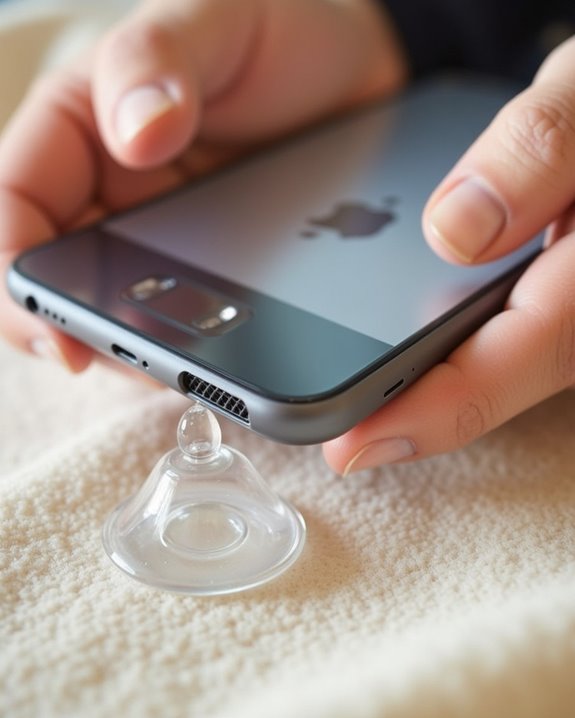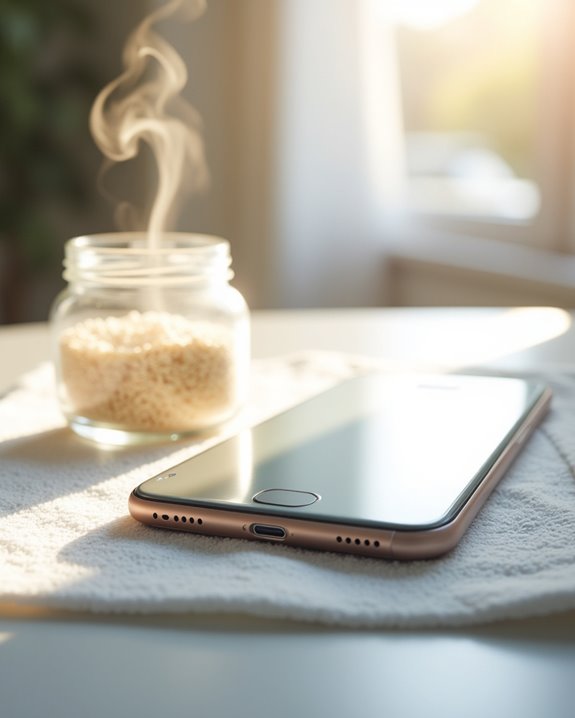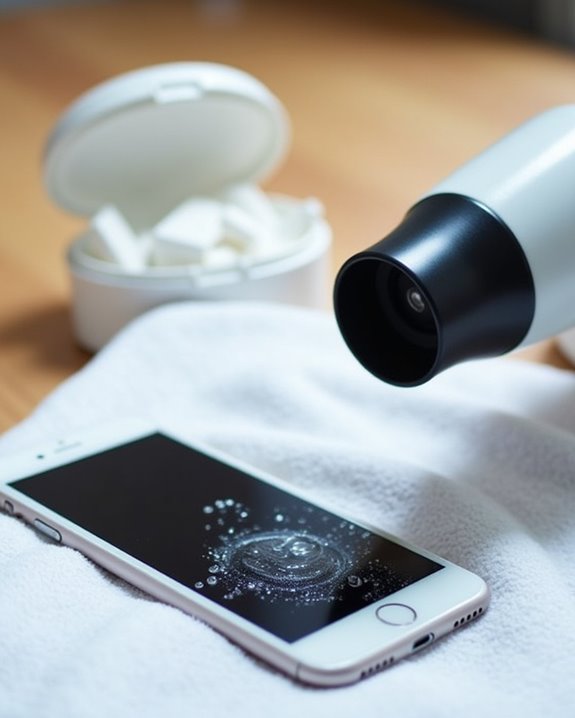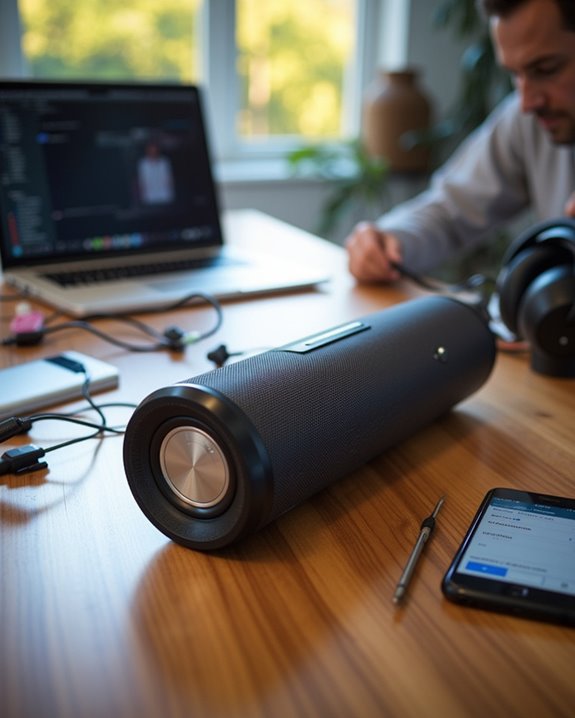To remove water from your phone speaker, follow these three steps: First, power down the device immediately to prevent electrical damage and assess visible moisture around ports. Second, position the phone speaker-side down at a slight incline to utilize gravity for drainage, then apply gentle suction with a small vacuum attachment for 10-15 seconds. Finally, allow 24-48 hours of complete air drying with silica gel packets nearby. Additional techniques can further minimize potential long-term component damage.
Key Takeaways
- Turn off your device immediately to prevent electrical damage and short circuits.
- Position your phone vertically with the speaker facing downward to let gravity drain water.
- Use a car vacuum with a small nozzle attachment for 10-15 second suction sessions.
- Play deep bass sounds through an online water-ejection tool to vibrate water out of speaker grilles.
- Allow 24-48 hours of complete air drying before using your phone again.
Turn Off Your Phone and Assess the Damage
Immediately powering down a water-exposed device serves as the critical first step in preventing potential short circuits and component damage. When liquid infiltrates the speaker or other components, the electrical conductivity of water creates hazardous conditions for sensitive internal circuits. Users should power off their devices without delay to minimize electrical flow through potentially compromised pathways.
After turning off the device, a thorough assessment becomes essential. Carefully examine all ports, particularly the speaker grilles, for visible moisture. Check for corrosion marks around connection points and inspect the SIM card tray for signs of liquid intrusion. Most modern smartphones contain Liquid Damage Indicator (LDI) strips that change from white to red when exposed to water, typically located near the SIM slot or battery compartment, providing definitive evidence of water contact.
Use Gravity and Gentle Suction Methods

Once the device is powered down and properly assessed, physical water extraction techniques become the next logical approach. Gravity techniques leverage the natural downward pull of water, requiring users to position their phone vertically with the speaker facing downward. This orientation, combined with a slight incline on a non-porous surface, maximizes drainage efficiency during the critical first 5-10 minutes.
For enhanced results, complementary suction alternatives can be employed after initial gravity drainage. A car vacuum with small nozzle attachment provides ideal low-pressure extraction without risking internal component damage. Users should apply brief 10-15 second vacuum sessions, repeating 2-3 times while maintaining the speaker-down position. This methodical approach achieves thorough moisture removal without subjecting delicate speaker membranes to excessive stress, preserving device functionality throughout the recovery process.
Dry Completely Before Using Again

Thorough drying represents the most critical phase in water damage recovery, requiring both patience and methodical attention to prevent lasting internal damage. Experts recommend allowing 24-48 hours of air drying in a well-ventilated space before resuming normal device operation. This Usage Delay, while inconvenient, greatly reduces the risk of electrical component failure.
For ideal Dryness Verification, users should inspect all ports and speaker openings for lingering moisture before powering on the device. Premature charging can cause short circuits in partially dried components, potentially resulting in permanent damage. Silica gel packets or microfiber cloths placed near (but not inside) the phone can accelerate moisture extraction during this critical waiting period. Professional technicians advise against attempting to expedite drying with heat sources, as these can warp internal components and compromise the device’s structural integrity.
Frequently Asked Questions
Can Salt Water Damage Be Treated the Same Way?
Salt water damage requires additional SaltWaterAlternatives beyond standard methods. The corrosive nature necessitates specialized CorrosionTreatmentMethods, including isopropyl alcohol cleaning and professional servicing. Immediate action is essential for preserving device functionality within the community of affected users.
How Long Should I Wait Before Turning My Phone On?
Patience is a virtue when dealing with wet phones. The recommended waiting period is 24-48 hours before attempting to power on the device. This power delay is essential for everyone who wants their phone functioning properly again.
Will My Warranty Cover Water Damage to Speakers?
Standard warranties typically exclude water damage to speakers per Warranty Terms. Manufacturers’ Claim Process requires immediate disclosure of liquid exposure. Most phone owners find protection only through additional accidental damage plans that specifically cover liquid intrusion.
Are Waterproof Phone Cases Truly 100% Effective?
Waterproof phone cases aren’t 100% effective despite Certification Standards suggesting otherwise. These Effectiveness Myths persist while cases remain vulnerable to manufacturing defects, user error, material degradation, and wear over time. Everyone faces these limitations.
Can I Use a Hairdryer to Speed up Drying?
Like traversing a minefield, using a hairdryer presents serious Hairdryer Risks to internal components. Low settings from a distance may help, but safer Drying Alternatives include air-drying, silica gel packets, or sound wave apps everyone recommends.





